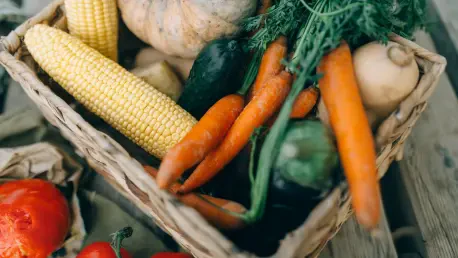In the heart of southwest Minnesota, a fourth-generation farming family has carved out an extraordinary legacy that intertwines personal achievement with community service, showcasing resilience and dedication. The Ruppert family, based in Murray County, transformed a modest 1.5-acre vegetable garden into a powerful vehicle for funding their children’s college education while nourishing thousands of schoolchildren through the Farm to School program. Over nearly two decades, Kimberly, Kerry, and their three children cultivated crops ranging from cucumbers to watermelons, evolving from earning a mere $100 at local farmers’ markets to becoming a vital supplier for regional schools. This inspiring narrative, recently spotlighted in a prominent Minnesota publication, captures not only the family’s determination but also the broader struggles within local agriculture. It raises critical questions about sustainability and the future of small-scale farming in supporting both families and communities.
A Family’s Remarkable Endeavor
Roots of Resilience and Growth
Spanning 18 years, the journey of this dedicated family in Murray County showcases a blend of ambition and grit that turned a small plot into a significant operation. Initially, their vegetable garden yielded only modest returns at local markets, but through persistent effort, the Rupperts expanded their reach. By joining the Farm to School initiative, they began supplying fresh produce like beets, carrots, and peppers to 10 school districts during the fall harvest season. This growth wasn’t merely about volume; it represented a commitment to quality and community impact. The financial proceeds were meticulously channeled into 529 college savings plans, amassing over $50,000 each for siblings Zachery and Katelyn. This strategic planning ensured that tuition and books were fully covered, allowing the siblings to pursue higher education without the burden of debt. Their story reflects a rare intersection of agricultural labor and educational opportunity, demonstrating how a family farm can serve as a foundation for future success.
Building Bonds Through Hard Work
Beyond the tangible financial gains, the family’s vegetable farming venture fostered intangible rewards that enriched their lives in unexpected ways. The long hours spent tending to the garden and delivering produce to schools created deep connections with the local community, forging relationships that Kimberly fondly describes as unforgettable encounters with truly remarkable individuals. These interactions weren’t just transactions; they were moments of shared purpose, linking the family to school staff, parents, and students who benefited from their harvests. Moreover, the experience instilled a profound work ethic in the children, equipping them with practical skills in gardening and logistics that transcended the farm. This endeavor became a classroom of its own, teaching resilience and responsibility while contributing to the nutritional well-being of thousands of young learners across the region. Such outcomes highlight the broader value of local farming initiatives in nurturing both personal growth and societal good.
The Hidden Costs of Farming
Unseen Burdens of the Harvest
Maintaining a 1.5-acre vegetable garden demanded an extraordinary level of dedication from the Ruppert family, often at the expense of personal leisure and comfort. From mid-April through the fall, their lives revolved around an unyielding cycle of planting, weeding, harvesting, and delivering produce to schools. Summer vacations, local concerts, and other typical seasonal enjoyments were sacrificed as the farm took precedence over everything else. The sheer physicality of the work—hauling heavy watermelons up the stairs of a century-old building, for instance—added layers of strain to their daily routine. This relentless schedule left little room for respite, painting a vivid picture of the hidden toll behind their bountiful harvests. It’s a stark reminder that small-scale farming, while rewarding, often comes with a steep personal cost that few outside the industry fully appreciate or understand.
Emotional and Logistical Challenges
The emotional and logistical hurdles faced by the family further underscore the complexities of their commitment to vegetable farming. Beyond the physical labor, meticulous record-keeping was essential to track production and sales, adding an administrative burden to their already packed days. Coordinating deliveries to multiple school districts required precise timing and navigation of logistical obstacles, often under tight deadlines during the harvest peak. Emotionally, the weight of knowing that thousands of children depended on their produce for healthy meals added a layer of responsibility that could feel both motivating and overwhelming. These challenges highlight the multifaceted nature of their operation, where success wasn’t just about growing crops but also about managing a web of interconnected tasks and expectations. Such realities reveal why this lifestyle, though impactful, is not easily sustainable for many who might consider entering the field.
A Tough Transition for Schools
Ripple Effects of Reduced Production
After nearly two decades of supplying fresh vegetables to schools, the family’s recent decision to scale back production marks a significant shift with immediate consequences for the 10 districts they served. Now focusing solely on watermelons and cantaloupe as their youngest child enters college, their broader contribution to local school menus has come to an end. This change has left food service directors grappling with uncertainty about sourcing comparable local produce. Michelle Hawkinson, representing Tracy Area Public Schools, voiced palpable concern, indicating that the absence of this reliable supplier will create a noticeable gap next year. Her apprehension reflects a broader anxiety among school officials who valued the consistent quality and proximity of the family’s offerings. This transition underscores the fragility of local food networks when key contributors step away from full-scale production.
Searching for Sustainable Alternatives
The challenge of replacing a trusted local supplier like the Rupperts extends beyond mere logistics; it touches on the viability of maintaining fresh, regionally sourced food in school cafeterias. School districts now face the daunting task of identifying new growers who can match the volume and reliability of the family’s past contributions. This search is complicated by the limited number of small-scale farmers willing or able to take on such commitments, especially in a region where agricultural priorities often lean toward larger commodity crops. The situation raises pressing questions about how schools can foster resilient partnerships with local producers to ensure continuity of supply. Without proactive solutions, there’s a risk that students may lose access to the nutritional benefits of fresh produce, potentially reverting to less healthy, non-local alternatives. This dilemma highlights the urgent need for supportive frameworks to bolster Farm to School connections.
Systemic Struggles in Agriculture
Economic Barriers for Small Growers
The experience of this Murray County family shines a harsh light on the economic realities that plague small-scale vegetable farming, despite its clear community benefits. Even as they fed thousands of children with fresh, nutritious produce, the income generated from these sales fell short of supporting a family as a primary livelihood. This stands in sharp contrast to the profitability of large-scale commodity crops like corn and soybeans, which benefit from substantial federal subsidies but don’t directly contribute to human nutrition in their raw form. Such disparities point to a troubling misalignment in agricultural priorities, where the production of healthy, local food is consistently undervalued. The family’s story serves as a compelling case for reevaluating economic incentives to better support growers who prioritize community health over mass production, revealing a critical gap in the current food system.
Policy and Structural Impediments
Addressing the systemic challenges in agriculture requires confronting policy and structural barriers that hinder small-scale farmers from thriving. The short growing season in Minnesota naturally limits earning potential for vegetable growers, while tight school budgets restrict the ability to pay premium prices for local produce. Recent cuts to federal funding for Farm to School programs have further strained resources, reducing schools’ capacity to invest in equipment for processing and storing fresh goods. These combined factors create a discouraging environment for farmers considering entry into this space or continuing existing operations. With 72% of Minnesota schools sourcing food locally during the 2022-2023 academic year, the ambition to expand such initiatives is evident, yet practical obstacles persist. A shift in policy—perhaps redirecting subsidies toward small growers—could help bridge this gap and ensure that local food production remains a viable pursuit.
Reflecting on a Legacy of Impact
Lessons from a Farming Family’s Past
Looking back, the 18-year journey of this southwest Minnesota family stands as a testament to the profound impact a single household can have on both personal aspirations and community welfare. Their dedication to growing vegetables not only secured over $50,000 for each of their children’s education but also provided thousands of schoolchildren with access to fresh, healthy meals. The labor-intensive path they walked—filled with early mornings, late nights, and endless tasks—reflected a commitment that went beyond financial gain, embedding values of hard work and service into their family’s core. Their recognition as Murray County Farm Family of the Year in 2021 was a fitting acknowledgment of their contributions, yet it also highlighted the irony that such impactful work couldn’t sustain them economically. This narrative became a powerful lens through which to view the challenges and rewards of small-scale agriculture in a system often tilted against it.
Paving the Way for Future Solutions
As the family stepped back from full vegetable production, their story left behind a call to action for systemic reform in how local food systems are supported. Schools that once relied on their harvests had to adapt, seeking new suppliers while grappling with budget constraints and limited options. Meanwhile, the broader agricultural landscape revealed its flaws—economic disincentives and policy gaps that made vegetable farming a noble but unsustainable endeavor for many. Moving forward, stakeholders must consider innovative approaches, such as consumer willingness to pay more for local produce or government incentives redirected toward small growers. Strengthening Farm to School programs with stable funding and infrastructure support could ensure that future generations of farmers aren’t deterred by the hardships this family faced. Their legacy challenges policymakers, educators, and communities to build a more equitable framework that values nutrition and local agriculture as cornerstones of societal health.









